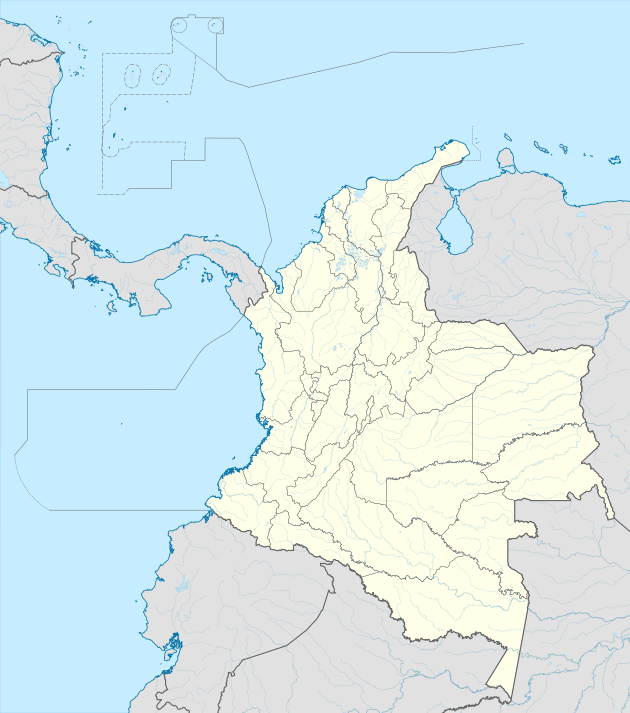Florida, Valle del Cauca
Florida (Spanish pronunciation: [floˈɾiða]) is a town and municipality located in the Department of Valle del Cauca, Colombia.
Florida | |
|---|---|
Municipality and town | |
 Flag .svg.png) Seal | |
 Location of the municipality and town of Florida, Valle del Cauca in the Valle del Cauca Department of Colombia. | |
 Florida Location in Colombia | |
| Coordinates: 3°19′39″N 76°14′19″W | |
| Country | |
| Department | Valle del Cauca Department |
| Population (2015) | |
| • Total | 58,122 |
| Time zone | UTC-5 (Colombia Standard Time) |
Its first inhabitants: indigenous peoples, mestizos, afro-Latinos and mulattos, established a new and vibrant home to a mix of the many cultures existent in the South-Eastern region of Valle del Cauca. Bathed by the Santa Barbara, Fraile, Parraga, and Desbaratado Rivers, the fertility of the land has maintained Florida at the heart of agricultural production within the region.
The town is a lively source of commercial activity, stemming from its main road, known as "la Calle Novena" or "Ninth Street". Surrounding this road are many of the towns most modern developments, as well as a continuously growing community of establishments of all types, offering the many products and services necessary to the region. "La Novena" is also home to la Plaza De Mercado, a flea market which is the principal fountain for the employment of the people of Florida. People from the entire region of Valle del Cauca arrive each day at this market, both selling and buying many products and foods, including a variety of fruit, vegetables, and crafts.
Tourists are attracted to the natural wonders of the rivers and mountains in the region of Florida. "La Hoya", a water pool formed by a section of the Fraile River, attracts many visitors each day. The beautiful landscape can be enjoy from a hike into the mountains, where many visitors go to capture the view from above.
The FARC requested this municipality together with Pradera as free areas for them to operate in order to start the negotiation to exchange 44 hostages they had, at the time of their request, for guerilla fighters kept in prison by the Colombian government.[2]
History
The foundation of this municipality has not been able to be specified exactly, according to the data collected by some historians with notary sources from Palmira Notaria first book 28, Florida was founded by the brothers Santos and Pantaleon Bedoya, who presented some lots to the priest Francisco Quijano and We read in the year of 1825, As stated in the appointments made by General Santander for this region in the process of consolidation of the indepense "Archive of Popayan", in the year of 1833, Mr. Antonio de la Quintana and Caycedo who had fought for the independence of the Grand Cauca. As for the Perodias farmhouse, it was in the Jesuit Doctrine Farm, which was owned by Father Pedro Dias Cienfuegos as it appears in the archives found in Quito, to whom the crown had ceded this undivided in order to indoctrinate indigenous people in turn use black slave labor in the work of the farm. However, their mission was affected when they were forced to leave these lands leaving the estate in the hands of the Franciscan priests of Popayan as recorded in the archives of Peru and the Archive of the Indies in Spain. For this reason the farm was named after its founder. The foundation of the urban area of Florida, for the year 1834, Messrs. Pantaleon Bedoya and Santos Bedoya brothers, together with the presbyter "as recorded in the notary archive of Palmira volume 28" donated the land, for the layout of the main square And some streets. There is no one else showing up donating land ... they were sold to black freed ex-slaves and mestizos ... even in the card game and the chicha small lots were lost that began to be used by their new owners in this way Florida on a palenquero settlement began its existence, as the historian Pena mentions in her text about palenques in the Grand Cauca.
It is more true to say that Florida was initially founded as a parish subject to the canton of Palmira, on September 22 of 1833, date recorded in the II Baptist Parish book of the years 1832 to 1836 or we can also take as the foundation date on October 22 of 1835 date on which the deed for the donation of the land was registered; it is more likely that the date of foundation is the first, because in the second, what is being legalized is the donation of the land, but the church was already built and the streets had already been laid and the land sold in the square, in Either case this changes the idea that some people and writings raise about the foundation; in which it is affirmed that Florida was founded in 1825 or 1826 and they use June 13 as the date, since this is the date of the patron saint festivities of San Antonio de Padua, patron of Florida for the Catholic Church.[3]
Notable people
- Jherson Vergara, footballer
- Róbinson Zapata, football player
References
- Florida: Recuperando la Memoria Colectiva. Convenio Interinstitucional de Cooperacion y Cofinanciacion. Florida, Valle del Cauca. 2006.
- El Tiempo, Enero 15 de 2008, Farc insisten en despeje de Florida y Pradera (Valle) para hacer el acuerdo humanitario
- Zúñiga, Mauricio (2011). Florida and its Tradition Origins and Roots of a People. El Frayle. pp. 154, 158, 168. ISBN 978-958-44-8733-9.